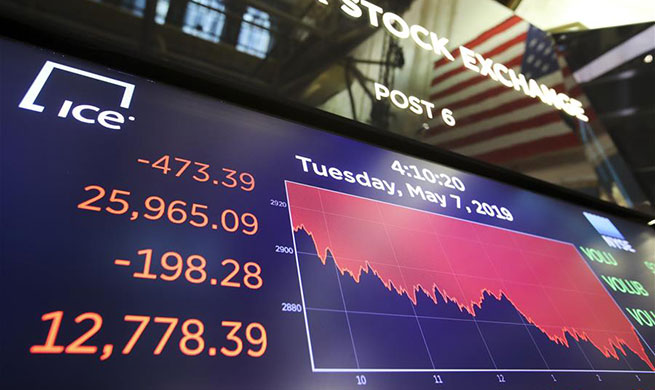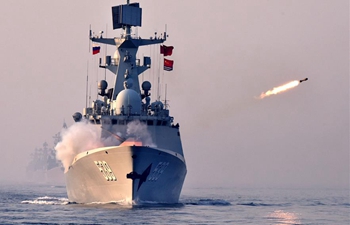NEW YORK, May 7 (Xinhua) -- Tuesday was a day for Wall Street to mourn, with the three major indexes running into deepening losses following Monday's declines, as traders and investors got spooked by a worsening prospect of global trade.
Around market close, the Dow Jones Industrial Average fell 473.39 points, or 1.79 percent, to 25,965.09. The S&P 500 decreased 48.42 points, or 1.65 percent, to 2,884.05. The Nasdaq Composite Index was down 159.53 points, or 1.96 percent, to 7,963.76.
Wall Street kicked off Tuesday with a dull start, with the Dow falling 195.75 points, or 0.74 percent, to 26,242.73, while the S&P 500 and the Nasdaq were both hit by double-digit point losses, down 0.79 percent and 0.89 percent respectively shortly after the opening bell.
Yet, their losses kept enlarging at a growing pace, with the Dow falling below the key level of 26,000 points by evaporating nearly 449 points around midday, while the losses of the S&P 500 and the Nasdaq both expanded by nearly four folds. As a consequence, the S&P 500 broke below its key level of 2,900 points, and the tech-heavy Nasdaq dived below the bar of 8,000 points.
Amid prevalent volatility, sell-offs of the three indexes speeded up during afternoon sessions.
The Dow tumbled over 500 points in early afternoon and then sank deeper into the red territory after losing over 600 points. It even plunged as much as 648.77 points at its low of the trading day, marking the biggest fall since early January.
The S&P 500 and the Nasdaq also bore intensifying pains, both on pace for their worst day since the start of 2019.
On the sector front, the 11 primary S&P 500 extended solid losses throughout the day, led by the information technology sector and the industrial sector, losing over 2.1 percent and over 2 percent respectively.
All of the 30 blue-chip stocks in the Dow were in red throughout Tuesday, led by Boeing and Caterpillar, whose shares dropped nearly 3.9 percent and nearly 2.3 percent respectively, as the two companies, widely seen as global trade bellwethers, own high overseas revenue exposure.
Boeing also broke below its 200-day moving average for the first time since January.
The tech sector has also continued to be pulled back primarily by chipmakers and semiconductor companies, both sensitive to global trade.
More specifically, shares of NVIDIA and Advanced Micro Devices declined over 3.7 percent and nearly 2.8 percent separately, among a bulk of underperformers.
The Cboe Volatility index, widely considered the best fear gauge in the stock market, increased 25.13 percent to 19.32 on Tuesday, an alarming rebound from Monday's 19.97 percent decrease.
Monday witnessed the three major indexes recover most of their lost grounds after steep tumbles earlier in the morning.
Notably, the Dow offset around 85 percent of an initial plunge of over 470 points, which reflected widespread market fears over escalating global trade frictions.













